Arduino
|
| |
|
Arduino Uno SMD R3 | |
| Developer | Arduino |
|---|---|
| Manufacturer | Many |
| Type | Single-board microcontroller |
| Operating system | None |
| CPU |
Atmel AVR (8-bit), ARM Cortex-M0+ (32-bit), ARM Cortex-M3 (32-bit), Intel Quark (x86) (32-bit) |
| Memory | SRAM |
| Storage | Flash, EEPROM |
| Website |
www www |
Arduino is an open source computer hardware and software company, project, and user community that designs and manufactures single-board microcontrollers and microcontroller kits for building digital devices and interactive objects that can sense and control objects in the physical world. The project's products are distributed as open-source hardware and software, which are licensed under the GNU Lesser General Public License (LGPL) or the GNU General Public License (GPL),[1] permitting the manufacture of Arduino boards and software distribution by anyone. Arduino boards are available commercially in preassembled form, or as do-it-yourself kits.
Arduino board designs use a variety of microprocessors and controllers. The boards are equipped with sets of digital and analog input/output (I/O) pins that may be interfaced to various expansion boards (shields) and other circuits. The boards feature serial communications interfaces, including Universal Serial Bus (USB) on some models, which are also used for loading programs from personal computers. The microcontrollers are typically programmed using a dialect of features from the programming languages C and C++. In addition to using traditional compiler toolchains, the Arduino project provides an integrated development environment (IDE) based on the Processing language project.
The Arduino project started in 2003 as a program for students at the Interaction Design Institute Ivrea in Ivrea, Italy,[2] aiming to provide a low-cost and easy way for novices and professionals to create devices that interact with their environment using sensors and actuators. Common examples of such devices intended for beginner hobbyists include simple robots, thermostats, and motion detectors.
The name Arduino comes from a bar in Ivrea, Italy, where some of the founders of the project used to meet. The bar was named after Arduin of Ivrea, who was the margrave of the March of Ivrea and King of Italy from 1002 to 1014.[3]
History
The origin of the Arduino project started at the Interaction Design Institute Ivrea (IDII) in Ivrea, Italy.[2] At that time, the students used a BASIC Stamp microcontroller at a cost of $100, a considerable expense for many students. In 2003 Hernando Barragán created the development platform Wiring as a Master's thesis project at IDII, under the supervision of Massimo Banzi and Casey Reas, who are known for work on the Processing language. The project goal was to create simple, low cost tools for creating digital projects by non-engineers. The Wiring platform consisted of a printed circuit board (PCB) with an ATmega168 microcontroller, an IDE based on Processing and library functions to easily program the microcontroller.[4] In 2003, Massimo Banzi, with David Mellis, another IDII student, and David Cuartielles, added support for the cheaper ATmega8 microcontroller to Wiring. But instead of continuing the work on Wiring, they forked the project and renamed it Arduino.[4]
The initial Arduino core team consisted of Massimo Banzi, David Cuartielles, Tom Igoe, Gianluca Martino, and David Mellis,[2] but Barragán was not invited to participate.[4]
Following the completion of the Wiring platform, lighter and less expensive versions were distributed in the open-source community.[5]
Adafruit Industries, a New York City supplier of Arduino boards, parts, and assemblies, estimated in mid-2011 that over 300,000 official Arduinos had been commercially produced,[6] and in 2013 that 700,000 official boards were in users' hands.[7]
Trademark dispute
In early 2008, the five cofounders of the Arduino project created a company, Arduino LLC,[8] to hold the trademarks associated with Arduino. The manufacture and sale of the boards was to be done by external companies, and Arduino LLC would get a royalty from them. The founding bylaws of Arduino LLC specified that each of the five founders transfer ownership of the Arduino brand to the newly formed company.
At the end of 2008, Gianluca Martino's company, Smart Projects, registered the Arduino trademark in Italy and kept this a secret from the other cofounders for about two years. This was revealed when the Arduino company tried to register the trademark in other areas of the world (they originally registered only in the US), and discovered that it was already registered in Italy. Negotiations with Gianluca and his firm to bring the trademark under control of the original Arduino company failed. In 2014, Smart Projects began refusing to pay royalties. They then appointed a new CEO, Federico Musto, who renamed the company Arduino SRL and created the website arduino.org, copying the graphics and layout of the original arduino.cc. This resulted in a rift in the Arduino development team.[9][10][11]
In January 2015, Arduino LLC filed a lawsuit against Arduino SRL.[12]
In May 2015, Arduino LLC created the worldwide trademark Genuino, used as brand name outside the United States.[13]
At the World Maker Faire in New York on October 1, 2016, Arduino LLC co-founder and CEO Massimo Banzi and Arduino SRL CEO Federico Musto announced the merger of the two companies.[14]
Hardware

Arduino is open-source hardware. The hardware reference designs are distributed under a Creative Commons Attribution Share-Alike 2.5 license and are available on the Arduino website. Layout and production files for some versions of the hardware are also available. The source code for the IDE is released under the GNU General Public License, version 2.[15] Nevertheless, an official Bill of Materials of Arduino boards has never been released by Arduino staff.
Although the hardware and software designs are freely available under copyleft licenses, the developers have requested the name Arduino to be exclusive to the official product and not be used for derived works without permission. The official policy document on use of the Arduino name emphasizes that the project is open to incorporating work by others into the official product.[16] Several Arduino-compatible products commercially released have avoided the project name by using various names ending in -duino.[17]
Most Arduino boards consist of an Atmel 8-bit AVR microcontroller (ATmega8, ATmega168, ATmega328, ATmega1280, ATmega2560) with varying amounts of flash memory, pins, and features.[19] The 32-bit Arduino Due, based on the Atmel SAM3X8E was introduced in 2012.[20] The boards use single or double-row pins or female headers that facilitate connections for programming and incorporation into other circuits. These may connect with add-on modules termed shields. Multiple, and possibly stacked shields may be individually addressable via an I²C serial bus. Most boards include a 5 V linear regulator and a 16 MHz crystal oscillator or ceramic resonator. Some designs, such as the LilyPad, run at 8 MHz and dispense with the onboard voltage regulator due to specific form-factor restrictions.
Arduino microcontrollers are pre-programmed with a boot loader that simplifies uploading of programs to the on-chip flash memory. The default bootloader of the Aduino UNO is the optiboot bootloader.[21] Boards are loaded with program code via a serial connection to another computer. Some serial Arduino boards contain a level shifter circuit to convert between RS-232 logic levels and transistor–transistor logic (TTL) level signals. Current Arduino boards are programmed via Universal Serial Bus (USB), implemented using USB-to-serial adapter chips such as the FTDI FT232. Some boards, such as later-model Uno boards, substitute the FTDI chip with a separate AVR chip containing USB-to-serial firmware, which is reprogrammable via its own ICSP header. Other variants, such as the Arduino Mini and the unofficial Boarduino, use a detachable USB-to-serial adapter board or cable, Bluetooth or other methods, when used with traditional microcontroller tools instead of the Arduino IDE, standard AVR in-system programming (ISP) programming is used.

The Arduino board exposes most of the microcontroller's I/O pins for use by other circuits. The Diecimila,[lower-alpha 1] Duemilanove,[lower-alpha 2] and current Uno[lower-alpha 3] provide 14 digital I/O pins, six of which can produce pulse-width modulated signals, and six analog inputs, which can also be used as six digital I/O pins. These pins are on the top of the board, via female 0.1-inch (2.54 mm) headers. Several plug-in application shields are also commercially available. The Arduino Nano, and Arduino-compatible Bare Bones Board[22] and Boarduino[23] boards may provide male header pins on the underside of the board that can plug into solderless breadboards.
Many Arduino-compatible and Arduino-derived boards exist. Some are functionally equivalent to an Arduino and can be used interchangeably. Many enhance the basic Arduino by adding output drivers, often for use in school-level education, to simplify making buggies and small robots. Others are electrically equivalent but change the form factor, sometimes retaining compatibility with shields, sometimes not. Some variants use different processors, of varying compatibility.
Official boards
The original Arduino hardware was produced by the Italian company Smart Projects.[24] Some Arduino-branded boards have been designed by the American companies SparkFun Electronics and Adafruit Industries.[25] As of 2016, 17 versions of the Arduino hardware have been commercially produced.
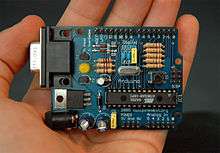 Arduino RS232[26]
Arduino RS232[26]
(thru-hole parts) Arduino Diecimila[27]
Arduino Diecimila[27] Arduino Duemilanove[28]
Arduino Duemilanove[28]
(rev 2009b)
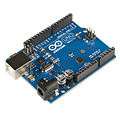 Arduino Uno SMD R3[31]
Arduino Uno SMD R3[31] Arduino Leonardo[32]
Arduino Leonardo[32]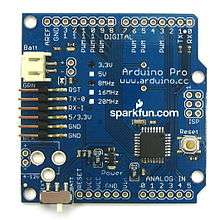 Arduino Pro[33]
Arduino Pro[33]
(No USB) Arduino Mega[34]
Arduino Mega[34]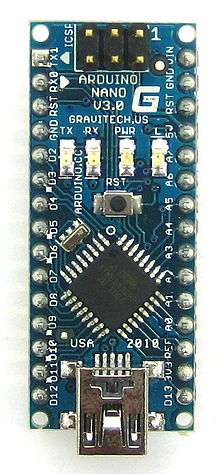 Arduino Nano[35]
Arduino Nano[35]
(DIP-30 footprint)- Arduino LilyPad 00[36]
(rev 2007) (No USB) 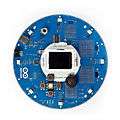 Arduino Robot[37]
Arduino Robot[37] Arduino Esplora[38]
Arduino Esplora[38]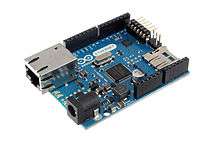 Arduino Ethernet[39]
Arduino Ethernet[39]
(AVR + W5100) Arduino Yun[40]
Arduino Yun[40]
(AVR + AR9331)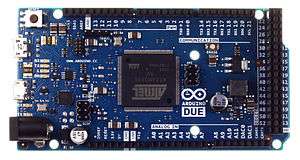
Shields
Arduino and Arduino-compatible boards use printed circuit expansion boards called shields, which plug into the normally supplied Arduino pin headers. Shields can provide motor controls for 3D printing and other applications, Global Positioning System (GPS), Ethernet, liquid crystal display (LCD), or breadboarding (prototyping). Several shields can also be made do it yourself (DIY).[42][43][44]
 Multiple shields can be stacked. In this example the top shield contains a solderless breadboard.
Multiple shields can be stacked. In this example the top shield contains a solderless breadboard. Dragino Lora Shield allows the user to send data and reach extremely long ranges at low data-rates.
Dragino Lora Shield allows the user to send data and reach extremely long ranges at low data-rates. Screw-terminal breakout shield in a wing-type format
Screw-terminal breakout shield in a wing-type format Adafruit Motor Shield with screw terminals for connection to motors
Adafruit Motor Shield with screw terminals for connection to motors Adafruit Datalogging Shield with a Secure Digital (SD) card slot and real-time clock (RTC) chip
Adafruit Datalogging Shield with a Secure Digital (SD) card slot and real-time clock (RTC) chip
Software development
|
Screenshot of the Arduino IDE showing the Blink simple beginner program | |
| Developer(s) | Arduino Software |
|---|---|
| Stable release |
1.8.3
/ 31 May 2017[45] |
| Repository |
github |
| Written in | Java, C, C++ |
| Operating system | Windows, macOS, Linux |
| Platform | IA-32, x86-64, ARM |
| Type | Integrated development environment |
| License | LGPL or GPL license |
| Website |
www |
A program for Arduino may be written in any programming language for a compiler that produces binary machine code for the target processor. Atmel provides a development environment for their microcontrollers, AVR Studio and the newer Atmel Studio.[46][47][48]
The Arduino project provides the Arduino integrated development environment (IDE), which is a cross-platform application written in the programming language Java. It originated from the IDE for the languages Processing and Wiring. It includes a code editor with features such as text cutting and pasting, searching and replacing text, automatic indenting, brace matching, and syntax highlighting, and provides simple one-click mechanisms to compile and upload programs to an Arduino board. It also contains a message area, a text console, a toolbar with buttons for common functions and a hierarchy of operation menus.
A program written with the IDE for Arduino is called a sketch.[49] Sketches are saved on the development computer as text files with the file extension .ino. Arduino Software (IDE) pre-1.0 saved sketches with the extension .pde.
The Arduino IDE supports the languages C and C++ using special rules of code structuring. The Arduino IDE supplies a software library from the Wiring project, which provides many common input and output procedures. User-written code only requires two basic functions, for starting the sketch and the main program loop, that are compiled and linked with a program stub main() into an executable cyclic executive program with the GNU toolchain, also included with the IDE distribution. The Arduino IDE employs the program avrdude to convert the executable code into a text file in hexadecimal encoding that is loaded into the Arduino board by a loader program in the board's firmware.
Software

A minimal Arduino C/C++ sketch, as seen by the Arduino IDE programmer, consist of only two functions:[50]
- setup(): This function is called once when a sketch starts after power-up or reset. It is used to initialize variables, input and output pin modes, and other libraries needed in the sketch.[51]
- loop(): After setup() has been called, function loop() is executed repeatedly in the main program. It controls the board until the board is powered off or is reset.[52]
Most Arduino boards contain a light-emitting diode (LED) and a load resistor connected between pin 13 and ground, which is a convenient feature for many tests and program functions.[53] A typical program for a beginning Arduino programmer blinks a LED repeatedly.
#define LED_PIN 13 // Pin number attached to LED.
void setup() {
pinMode(LED_PIN, OUTPUT); // Configure pin 13 to be a digital output.
}
void loop() {
digitalWrite(LED_PIN, HIGH); // Turn on the LED.
delay(1000); // Wait 1 second (1000 milliseconds).
digitalWrite(LED_PIN, LOW); // Turn off the LED.
delay(1000); // Wait 1 second.
}
This program uses the functions pinMode(), digitalWrite(), and delay(), which are provided by the internal libraries included in the IDE environment.[54][55][56] The program is usually loaded in the Arduino by the manufacturer. Arduino IDE and C language allow the programming of the low level registers in the atmega328P. instructions like DDRB=0b00000001 for changing PORTB input/output pins are allowed.
Applications
- Xoscillo, an open-source oscilloscope[57]
- Arduinome, a MIDI controller device that mimics the Monome
- OBDuino, a trip computer that uses the on-board diagnostics interface found in most modern cars
- Ardupilot, drone software and hardware
- Gameduino, an Arduino shield to create retro 2D video games[58]
- ArduinoPhone, a do-it-yourself cellphone[59][60]
- Water quality testing platform[61]
- Automatic titration system based on Arduino and stepper motor[62]
- Low cost data glove for virtual reality applications[63]
- Impedance sensor system to detect bovine milk adulteration[64]
- Homemade CNC using Arduino and DC motors with close loop control by Homofaciens[65]
- DC motor control using Arduino and H-Bridge[66]
- C-STEM Studio, a platform for hands-on integrated learning of computing, science, technology, engineering, and mathematics (C-STEM) with robotics.
Recognitions
The Arduino project received an honorary mention in the Digital Communities category at the 2006 Prix Ars Electronica.[67]
See also
Notes
References
- ↑ "Arduino - Introduction". arduino.cc.
- 1 2 3 David Kushner (2011-10-26). "The Making of Arduino". IEEE Spectrum.
- ↑ Justin Lahart (27 November 2009). "Taking an Open-Source Approach to Hardware". The Wall Street Journal. Retrieved 2014-09-07.
- 1 2 3 Hernando Barragán (2016-01-01). "The Untold History of Arduino". arduinohistory.github.io. Retrieved 2016-03-06.
- ↑ "Rhizome - Interview with Casey Reas and Ben Fry". 2009-09-23. Retrieved 2014-08-23.
- ↑ "How many Arduinos are "in the wild?" About 300,000". Adafruit Industries. May 15, 2011. Retrieved 2013-05-26.
- ↑ "Arduino FAQ – With David Cuartielles". Malmö University. April 5, 2013. Retrieved 2014-03-24.
- ↑ "Business Entity Summary for Arduino LLC". Mass.gov. State of Massachusetts.
- ↑ Allan, Alasdair (6 March 2015). "Arduino Wars: Group Splits, Competing Products Revealed?". makezine.com. Maker Media, Inc. Retrieved 21 April 2015.
- ↑ Banzi, Massimo (19 March 2015). "Massimo Banzi: Fighting for Arduino". makezine.com. Maker Media, Inc. Retrieved 21 April 2015.
- ↑ Williams, Elliot (28 March 2015). "Arduino SRL to Distributors: "We’re the Real Arduino"". Hackaday.com. Hackaday.com. Retrieved 21 April 2015.
- ↑ Arduino LLC vs Arduino SRL lawsuit; United States Courts Archive.
- ↑ "Arduino Announces New Brand, Genuino, Manufacturing Partnership with Adafruit". Make:. 16 May 2015. Retrieved 17 May 2015.
- ↑ "Arduino Blog – Two Arduinos become one". Arduino Blog. Retrieved 2016-10-02.
- ↑ "The arduino source code". The Arduino source code.
- ↑ "Policy". Arduino.cc. Retrieved 2013-01-18.
- ↑ "Freeduino Open Designs". Freeduino.org. Retrieved 2008-03-03.
- ↑ "Hardware Index". Arduino Project. Retrieved 2013-12-10.
- ↑ https://www.arduino.cc/en/Main/Products
- ↑ https://www.wired.com/2012/10/arduino-due/
- ↑ "Optiboot Bootloader for Arduino and Atmel AVR". Retrieved 2015-10-01.
- ↑ "Bare Bones Board".
- ↑ "Boarduino".
- ↑ "Redirect...". smartprj.com.
- ↑ Schmidt, M. ["Arduino: A Quick Start Guide"], Pragmatic Bookshelf, January 22, 2011, Pg. 201
- ↑ Arduino RS232 official webpage (arduino.cc)
- ↑ Arduino Diecimila official webpage (arduino.cc)
- ↑ Arduino Duemilanove official webpage (arduino.cc)
- ↑ Arduino Uno official webpage (arduino.cc)
- ↑ Differences between Official Arduino Uno, R2, R3 boards; Starting Electronics.
- ↑ Arduino Uno SMD official webpage (arduino.cc)
- ↑ Arduino Leonardo official webpage (arduino.cc)
- ↑ Arduino Pro official webpage (arduino.cc)
- ↑ Arduino Mega official webpage (arduino.cc)
- ↑ Arduino Nano official webpage (arduino.cc)
- ↑ Arduino LilyPad official webpage (arduino.cc)
- ↑ Arduino Robot official webpage (arduino.cc)
- ↑ Arduino Esplora official webpage (arduino.cc)
- ↑ Arduino Ethernet official webpage (arduino.cc)
- ↑ Arduino Yun official webpage (arduino.cc)
- ↑ Arduino Due official webpage (arduino.cc)
- ↑ "Arduino breadboard shield: $10 & 10 mins". todbot blog.
- ↑ "Arduino Shields for Prototyping". tigoe.net.
- ↑ Jonathan Oxer. "Arduino Shield list". Retrieved 5 Nov 2013.
- ↑ "Arduino Software Release Notes". Arduino Project. Retrieved April 9, 2017.
- ↑ "Using Atmel Studio for Arduino development". Megunolink.com. Retrieved 2013-01-18.
- ↑ "Using AVR Studio for Arduino development". Engblaze.com. Retrieved 2013-01-18.
- ↑ "Ch Arduino". Retrieved 2016-10-07.
- ↑ "Programming Arduino Getting Started with Sketches". McGraw-Hill. Nov 8, 2011. Retrieved 2013-03-28.
- ↑ Tutorial: Bare Minimum code needed (arduino.cc)
- ↑ Documentation for function setup (arduino.cc)
- ↑ Documentation for function loop (arduino.cc)
- ↑ "Blink Tutorial". Arduino.cc.
- ↑ Documentation for function pinMode (arduino.cc)
- ↑ Documentation for function digitalWrite (arduino.cc)
- ↑ Documentation for function delay (arduino.cc)
- ↑ "xoscillo – A software oscilloscope that acquires data using an arduino or a parallax (more platforms to come). – Google Project Hosting". Code.google.com. Retrieved 2013-01-18.
- ↑ "Gameduino home page". excamera.com.
- ↑ ArduinoPhone. Instructables.com (2013-07-17). Retrieved on 2013-08-04.
- ↑ DIY Cellphone, MIT
- ↑ Bas Wijnen, G. C. Anzalone and Joshua M. Pearce, Open-source mobile water quality testing platform., Journal of Water, Sanitation and Hygiene for Development, 4(3) pp. 532–537 (2014). doi:10.2166/washdev.2014.137 open access
- ↑ Grossi, Marco; Riccò, Bruno (February 2017). "An automatic titration system for oil concentration measurement in metalworking fluids". Measurement. 97: 8–14. doi:10.1016/j.measurement.2016.11.014.
- ↑ Silva, L.; Dantas, R.; Pantoja, A.; Pereira, A. (1 July 2013). "Development of a low cost dataglove based on arduino for virtual reality applications". 2013 IEEE International Conference on Computational Intelligence and Virtual Environments for Measurement Systems and Applications (CIVEMSA): 55–59. doi:10.1109/CIVEMSA.2013.6617395.
- ↑ Durante, Gabriel; Becari, Wesley; Lima, Felipe A. S.; Peres, Henrique E. M. (February 2016). "Electrical Impedance Sensor for Real-Time Detection of Bovine Milk Adulteration". IEEE Sensors Journal. 16 (4): 861–865. doi:10.1109/JSEN.2015.2494624.
- ↑ Homofaciens.de, CNC V2.0. Retrieved 2016-02-24
- ↑ DarkBlueBit.com, Arduino Robot – Motor Control. Retrieved 2016-04-16
- ↑ "Ars Electronica Archiv". Retrieved 2015-03-27.
Further reading
- Getting Started with Arduino; Massimo Banzi, Michael Shiloh; 262 pages; 2014; ISBN 1-4493-6333-4.
- Make: Sensors; Tero Karvinen, Kimmo Karvinen, Ville Valtokari; 400 pages; 2014; ISBN 978-1-4493-6810-4.
- Arduino For Dummies; John Nussey; 446 pages; 2013; ISBN 978-1118446379.
- Programming Arduino Next Steps: Going Further with Sketches; Simon Monk; 2013; ISBN 978-0071830256.
- Exploring Arduino: Tools and Techniques for Engineering Wizardry; Jeremy Blum; 384 pages; 2013; ISBN 978-1118549360.
- Arduino Workshop: A Hands-On Introduction with 65 Projects; John Boxall; 392 pages; 2013; ISBN 978-1593274481.
- Beginning C for Arduino: Learn C Programming for the Arduino and Compatible Microcontrollers; Jack Purdum; 280 pages; 2012; ISBN 978-1430247760.
- Programming Arduino: Getting Started With Sketches; Monk Simon; 162 pages; 2011; ISBN 978-0071784221.
- Make: Electronics (Learning by Discovery); Charles Platt; 352 pages; 2009; ISBN 978-0596153748.
External links
| Wikimedia Commons has media related to Arduino. |
- Official website
- Evolution tree for Arduino
- Arduino Cheat Sheet
- Arduino Dimensions and Hole Patterns
- Arduino Board Pinout Diagrams: Due, Esplora, Ethernet, Fio, Leonardo, LilyPad, Mega, Micro, Mini, Nano, Pro, Pro Micro, Pro Mini, Uno, Yun
- Historical
- Arduino - The Documentary (2010): IMDb, Vimeo
- Massimo Banzi interviews: Triangulation 110, FLOSS 61
- Untold History of Arduino - Hernando Barragán
- Lawsuit documents from Arduino LLC vs. Arduino S.R.L. et al - United States Courts Archive
